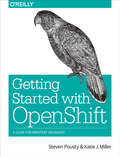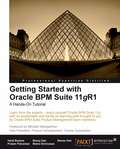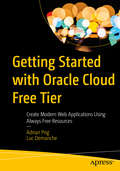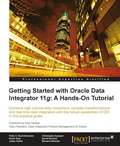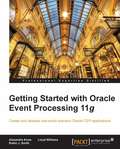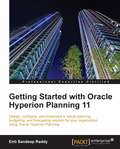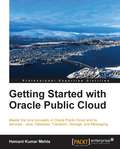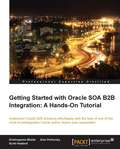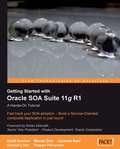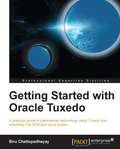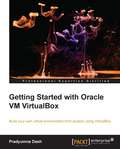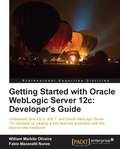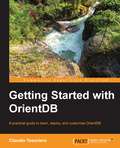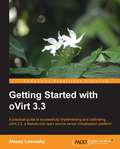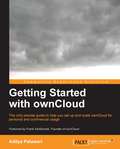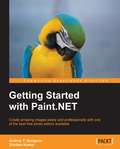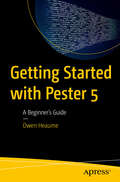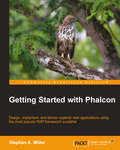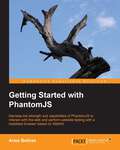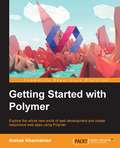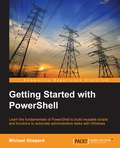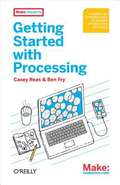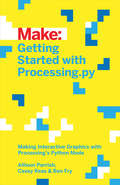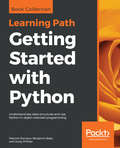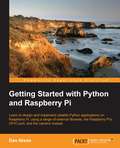- Table View
- List View
Getting Started with OpenShift
by Steve Pousty Katie MillerIntrigued by the possibilities of developing web applications in the cloud? With this concise book, you get a quick hands-on introduction to OpenShift, the open source Platform as a Service (PaaS) offering from Red Hat. You'll learn the steps necessary to build, deploy, and host a complete real-world application on OpenShift, without having to read long, detailed explanations of the technologies involved.Though the book uses Python, application examples in other languages are available on GitHub. If you can build web applications, use a command line, and program in Java, Python, Ruby, Node.js, PHP, or Perl, you're ready to get started.Dive in and create your first example application with OpenShiftModify the example with your own code and hot-deploy the changesAdd components such as a database, task scheduling, and monitoringUse external libraries and dependencies in your applicationDelve into networking, persistent storage, and backup optionsExplore ways to adapt your team processes to use OpenShiftLearn OpenShift terms, technologies, and commandsGet a list of resources to learn more about OpenShift and PaaS
Getting Started with Oracle BPM Suite 11gR1 – A Hands-On Tutorial
by Heidi BuelowThis fully illustrated step-by-step tutorial is based on proven training content that has been highly praised by hundreds of developers in product training courses given as part of the BPM Suite 11g rollout. You will learn how to build a business process application project iteratively with each chapter introducing new technology components and adding a functional increment. Each chapter comes with a working solution for your reference. You can use the solution to start the tutorial at any point or to jump around to the chapters most interesting to you. This clear and detailed tutorial is perfect for both new and experienced business process developers, process architects, and process analysts looking for a pragmatic and hands-on approach to learning Oracle BPM Suite 11g.
Getting Started with Oracle Cloud Free Tier: Create Modern Web Applications Using Always Free Resources
by Adrian Png Luc DemancheUse this comprehensive guide to get started with the Oracle Cloud Free Tier. Reading this book and creating your own application in the Free Tier is an excellent way to build familiarity with, and expertise in, Oracle Cloud Infrastructure. Even better is that the Free Tier by itself is capable enough and provides all the ingredients needed for you to create secure and robust, multi-tiered web applications of modest size. Examples in this book introduce the broad suite of Always Free options that are available from Oracle Cloud Infrastructure. You will learn how to provision autonomous databases and autonomous Linux compute nodes. And you will see how to use Terraform to manage infrastructure as code. You also will learn about the virtual cloud network and application deployment, including how to create and deploy public-facing Oracle Application Express solutions and three-tier web applications on a foundation of Oracle REST Data Services. The book also includes a brief introduction to using and managing access to Oracle Machine Learning Notebooks.Cloud computing is a strong industry trend. Mastering the content in this book leaves you well-positioned to make the transition into providing and supporting cloud-based applications and databases. You will have the knowledge and skills that you need to deploy modest applications along with a growing understanding of Oracle’s Cloud platform that will serve you well as you go beyond the limits of the Always Free options and take full advantage of all that Oracle Cloud Infrastructure can offer.What You Will LearnKnow which resources are available for free forever from Oracle Cloud InfrastructureProvision your virtual cloud networkHost, manage, and monitor web applications using the freely available componentsProvision and manage Autonomous Databases and Autonomous Linux Compute NodesUse and manage access to Oracle Machine Learning NotebooksAutomate and manage your infrastructure as code using TerraformMonitor and manage costs when you grow beyond the Always Free platformWho This Book Is ForDatabase administrators and application developers who want to learn about Oracle’s cloud offerings, application developers seeking a robust platform on which to build and deploy modest applications at zero cost, and developers and administrators interested in exploring Oracle Application Express running on a self-managing, self-tuning Oracle Database
Getting Started with Oracle Data Integrator 11g: A Hands-On Tutorial
by David Hecksel Peter C. Boyd-Bowman Bernard WheelerGetting Started with Oracle Data Integrator 11g: A Hands-On Tutorial is a practical tutorial bursting with tips, illustrations and real-world best practices to get you on your way with ODI. If you are a software/ETL developer or database administrator who is new to Oracle Data Integrator but want to get hands-on with the product quickly, then Getting Started with Oracle Data Integrator 11g: A Hands-On Tutorial is for you. You should have some experience with databases, SQL and ETL technologies.
Getting Started with Oracle Event Processing 11g
by Alexandre Alves Robin J. Smith Lloyd WilliamsThis getting started book will use practical chapters which follow logical and progressively more complex tasks and examples, which will impart the skills of how to use Oracle Complex Event Processing to the reader. This book is aimed at both those with some knowledge of java and SQL database experience, but it is also written so that if you are completely new to this topic you will understand this new technology domain no matter your background or industry.
Getting Started with Oracle Hyperion Planning 11
by Enti Sandeep ReddyThis book follows a tutorial-based approach that will provide you with step-by-step instructions to configure and implement a robust planning, budgeting, and forecasting solution. Each chapter provides clear instructions and detailed screenshots, as you approach a new facet of the Hyperion Planning environment. If you want to successfully implement Oracle Hyperion Planning solutions, then this book is for you. Familiarity with Oracle Essbase and OLAP would be beneficial but is not essential. While the book is intended for beginners, even experienced Planning developers and users will benefit from this book.
Getting Started with Oracle Public Cloud
by Hemant Kumar MehtaA step-by step tutorial to get started with Oracle Public Cloud and its services. This book is targeted at users who wish to explore the Oracle Public Cloud services. Readers should be well aware of Java Enterprise Edition, Oracle Database, and JMS.
Getting Started with Oracle SOA B2B Integration: A Hands-On Tutorial
by Alan Perlovsky Krishnaprem Bhatia Scott HaalandThis hands on tutorial gives you the best possible start you could hope for with Oracle B2B. Learn using real life scenarios and examples to give you a solid footing of B2B.This book is for B2B architects, consultants and developers who would like to design and develop B2B integrations using Oracle B2B. This book assumes no prior knowledge of Oracle B2B and explains all concepts from scratch using illustrations, real world examples and step-by-step instructions. The book covers enough depth and details to be useful for both beginner and advanced B2B users.
Getting Started With Oracle SOA Suite 11g R1 – A Hands-On Tutorial
by Heidi Buelow Demed L'HerThis fully illustrated step-by-step tutorial is based on proven training material that has been highly praised by hundreds of developers in product training courses given as part of the SOA Suite 11g rollout. You will learn how to build a services-oriented composite application project iteratively with each chapter introducing new technology components and adding a functional increment. Each chapter comes with a working solution for your reference. You can use the solution to start the tutorial at any point or to jump around to the chapters that most interest you. This clear and detailed tutorial is perfect for both new and experienced SOA developers looking for a pragmatic and hands-on approach to learning Oracle SOA Suite 11g.
Getting Started with Oracle Tuxedo
by Biru ChattopadhayayThis book is packed with real world examples that cover the design and discipline of the software and service of CRMOD. If you are an architect, designer, developer or administrator looking for a quick reference guide on how to build a Tuxedo application, then this is the best guide for you. This book also helps business users to understand this technology, various features, and functionalities and relate business benefits. No prior knowledge of Tuxedo is required.
Getting Started with Oracle VM VirtualBox
by Pradyumna DashThis book is for system administrators, technical architects, and virtualization enthusiasts who want to learn how to set up a virtual machine. Knowledge of the Linux environment is expected. Prior experience with VirtualBox or knowledge of virtualization is not required.
Getting Started with Oracle WebLogic Server 12c: Developer’s Guide
by William Markito Oliveira Fabio Mazanatti NunesGetting Started with Oracle WebLogic Server 12c is a fast-paced and feature-packed book, designed to get you working with Java EE 6, JDK 7 and Oracle WebLogic Server 12c straight away, so start developing your own applications.Getting Started with Oracle WebLogic Server 12c: Developer's Guide is written for developers who are just getting started, or who have some experience, with Java EE who want to learn how to develop for and use Oracle WebLogic Server. Getting Started with Oracle WebLogic Server 12c: Developer's Guide also provides a great overview of the updated features of the 12c release, and how it integrates Java EE 6 and JDK 7 to remove boilerplate code.
Getting Started with OrientDB
by Claudio TesorieroA standard tutorial aimed at making you an OrientDB expert, through the use of practical examples, explained in a step-by-step format.Getting Started with OrientDB 1.3.0 is great for database designers, developers, and systems engineers. It is assumed that you are familiar with NoSQL concepts, Java, and networking principles.
Getting Started with oVirt 3.3
by Alexey LesovskyGetting Started with oVirt 3.3 has a tutorial-based approach to learning oVirt KVM virtualization. This book will introduce you to the various components of the oVirt engine and will show you how to implement virtualization.This book is designed for technicians and system administrators who are interested in virtualization technology in Linux / UNIX. It is assumed that you have an understanding of virtualization in general as well as what issues it solves. You will also need a basic knowledge of how to work on the command line in Linux.
Getting Started with ownCloud
by Aditya PatawariThis is a standard, precise, and short tutorial for setting up ownCloud and includes advanced topics like encryption, user management, and server security. This ownCloud book would be an ideal starting point for anyone who wants to store their data and also share it.This book is for first time users as well as administrators who are interested or responsible for managing an ownCloud instance. You do not need any prior experience with any of the technology, including Linux/Windows, Apache/IIS, SQLite/MySQL, or even PHP. It is a beginner-friendly book, written with a first time user in mind.
Getting Started with Paint.NET
by Andros T. Sturgeon Shoban KumarThis book follows a tutorial-based approach and is packed with examples in a compact and concise format.If you have ever wanted to create photos and images that go beyond simple point and shoot results, then this book is for you. This book will help you create artistic images in ways that are only limited by your imagination. No prior knowledge of photo editing or editing software is required.
Getting Started with Pester 5: A Beginner's Guide
by Owen HeaumeEmbark on a transformative journey into the world of Pester and elevate your PowerShell scripting to new heights of robustness, reliability, and efficiency. This comprehensive beginner's guide provides a hands-on approach to PowerShell testing using Pester, empowering you to enhance your code quality with confidence.The book starts with an introduction to Pester, the powerful testing and mocking framework for PowerShell. You'll gain a solid foundation by exploring Pester's fundamental building blocks. The book guides you through the phases of Pester, helping you write your initial Pester code. You will dive into topics such as tags, assertions with Should and parameter filters, and you will explore advanced techniques such as Test Drive and Test Registry.You will discover the art of mocking in Pester and master its advanced testing methodologies. You will gain insights into working without installed modules and seamlessly integrating Pester with Azure DevOps Pipeline for a streamlined testing process.After reading this book, you will have the knowledge and skills to initiate your own exploration into PowerShell testing with Pester. You will transform your scripts into reliable powerhouses, ensuring the resilience and quality of your PowerShell code.What Will You LearnBuilding blocks and phases of PesterWriting effective Pester testsAssertions, mocking, and advanced testing techniquesIntegration with Azure DevOpsTags, code coverageWho This Book Is ForPowerShell scripters and Pester Framework beginners
Getting Started with Phalcon
by Stephan A. MillerThis step-by-step, practical guide filled with detailed steps and screenshots will help you discover the Phalcon extension and will enable you to build your blog application with Phalcon quickly and easily. If you are a PHP developer with some knowledge and experience of working with PHP and you want to develop stunning web applications easily and quickly, then this book is perfect for you. Learning how to use Phalcon is perhaps the best way to explore the MVC architecture.
Getting Started with PhantomJS
by Aries BeltranThe book will follow aA standard tutorial approach, and will beas a complete guide detailing the major aspects of PhantomJS with particular focus on Website website Testingtesting.This book is written forIf you are a JavaScript developers who are is interested in developing applications that interact with various web services, and doing that using a headless browser, then this book is ideal for you. This book iswill also be good for you if you are planning to create a headless browser testing for your web application. Basic understanding of JavaScript is assumed.
Getting Started with Polymer
by Arshak KhachatrianExplore the whole new world of web development and create responsive web apps using Polymer About This Book * Get to grips with the principles of Material Design and Google Web components * Make full use of the Polymer Designer Tool, Polymer Starter Kit, and Dart to create responsive web apps * An in-depth guide with real-life examples so you can learn everything you need to know about Polymer Who This Book Is For If you are a beginner-level web developer who would like to learn the concepts of web development using the Polymer library, then this is the book for you. Knowledge of JavaScript and HTML is expected. What You Will Learn * Understand the basics of web components such as Shadow DOM, HTML imports, Templates, and custom elements * Familiarize yourself with the principles of Material Design * Install Polymer on your system and create your project structure * Use the different Polymer 1.0 elements in your code * Work with Polymer.dart and create your own app * Get to know the best practices in Polymer programming from the top guys in the Polymer team In Detail Polymer is a library that helps you develop fast, responsive applications for the desktop and mobile web. It uses the Web Components specifications for the components and Material Design concepts to create a beautiful user interface. This focused, fast-paced guide deals with Polymer web components. We will cover layouts, attributes, elements, and handling touch and gesture events. You will also see how to build custom web components and applications using Polymer. Don't want to code? You can make the most of the Polymer Designer Tool app and create your own app without coding at all. Finally, you will see how you can improve your Polymer application by reading the best practices from Google Polymer team. By the end of this book, you will be equipped with all the necessary skills to use Polymer to create custom web components. Style and approach This is your guide to designing custom web components, and the concepts are explained in a conversational and easy-to-follow style. Each topic is explained through examples, with detailed explanations wherever required.
Getting Started with PowerShell
by Michael ShepardLearn the fundamentals of PowerShell to build reusable scripts and functions to automate administrative tasks with Windows About This Book * Harness the capabilities of the PowerShell system to get started quickly with server automation * Learn to package commands into a reusable script and add control structures and parameters to make them flexible * Get to grips with cmdlets that allow you to perform administration tasks efficiently Who This Book Is For This book is intended for Windows administrators or DevOps users who need to use PowerShell to automate tasks. Whether you know nothing about PowerShell or know just enough to get by, this guide will give you what you need to go to take your scripting to the next level. What You Will Learn * Learn to verify your installed version of PowerShell, upgrade it, and start a PowerShell session using the ISE * Discover PowerShell commands and cmdlets and understand PowerShell formatting * Use the PowerShell help system to understand what particular cmdlets do * Utilise the pipeline to perform typical data manipulation * Package your code in scripts, functions, and modules * Solve common problems using basic file input/output functions * Find system information with WMI and CIM * Automate IIS functionality and manage it using the WebAdministration module In Detail Windows PowerShell is a task-based command-line shell and scripting language designed specifically for system administration. Built on the .NET Framework, Windows PowerShell helps IT professionals and power users control and automate the administration of the Windows operating system and applications that run on Windows. PowerShell is great for batch importing or deleting large sets of user accounts and will let you collect a massive amount of detailed system information in bulk via WMI (Windows Management Instrumentation). Getting Started with PowerShell is designed to help you get up and running with PowerShell, taking you from the basics of installation, to writing scripts and web server automation. This book, as an introduction to the central topics of PowerShell, covers finding and understanding PowerShell commands and packaging code for reusability, right through to a practical example of automating IIS. It also includes topics such as installation and setup, creating scripts, automating tasks, and using Powershell to access data stores, registry, and file systems. You will explore the PowerShell environment and discover how to use cmdlets, functions, and scripts to automate Windows systems. Along the way, you will learn to perform data manipulation and solve common problems using basic file input/output functions. By the end of this book, you will be familiar with PowerShell and be able to utilize the lessons learned from the book to automate your servers. Style and approach A practical learning guide, complete with plenty of activities, examples and screenshots.
Getting Started with Processing
by Ben Fry Casey ReasLearn computer programming the easy way with Processing, a simple language that lets you use code to create drawings, animation, and interactive graphics. Programming courses usually start with theory, but this book lets you jump right into creative and fun projects. It's ideal for anyone who wants to learn basic programming, and serves as a simple introduction to graphics for people with some programming skills. Written by the founders of Processing, this book takes you through the learning process one step at a time to help you grasp core programming concepts. You'll learn how to sketch with code -- creating a program with one a line of code, observing the result, and then adding to it. Join the thousands of hobbyists, students, and professionals who have discovered this free and educational community platform. Quickly learn programming basics, from variables to objects Understand the fundamentals of computer graphics Get acquainted with the Processing software development environment Create interactive graphics with easy-to-follow projects Use the Arduino open source prototyping platform to control your Processing graphics
Getting Started with Processing.py: Making Interactive Graphics with Python's Processing Mode
by Casey Reas Ben Fry Allison ParrishProcessing opened up the world of programming to artists, designers, educators, and beginners. The Processing.py Python implementation of Processing reinterprets it for today's web. This short book gently introduces the core concepts of computer programming and working with Processing. Written by the co-founders of the Processing project, Reas and Fry, along with co-author Allison Parrish, Getting Started with Processing.py is your fast track to using Python's Processing mode.
Getting Started with Python: Understand key data structures and use Python in object-oriented programming
by Fabrizio Romano Benjamin Baka Dusty PhillipsHarness the power of Python objects and data structures to implement algorithms for analyzing your data and efficiently extracting informationKey FeaturesTurn your designs into working software by learning the Python syntaxWrite robust code with a solid understanding of Python data structuresUnderstand when to use the functional or the OOP approachBook DescriptionThis Learning Path helps you get comfortable with the world of Python. It starts with a thorough and practical introduction to Python. You’ll quickly start writing programs, building websites, and working with data by harnessing Python's renowned data science libraries. With the power of linked lists, binary searches, and sorting algorithms, you'll easily create complex data structures, such as graphs, stacks, and queues. After understanding cooperative inheritance, you'll expertly raise, handle, and manipulate exceptions. You will effortlessly integrate the object-oriented and not-so-object-oriented aspects of Python, and create maintainable applications using higher level design patterns. Once you’ve covered core topics, you’ll understand the joy of unit testing and just how easy it is to create unit tests.By the end of this Learning Path, you will have built components that are easy to understand, debug, and can be used across different applications.This Learning Path includes content from the following Packt products:Learn Python Programming - Second Edition by Fabrizio RomanoPython Data Structures and Algorithms by Benjamin BakaPython 3 Object-Oriented Programming by Dusty PhillipsWhat you will learnUse data structures and control flow to write codeUse functions to bundle together a sequence of instructionsImplement objects in Python by creating classes and defining methodsDesign public interfaces using abstraction, encapsulation and information hidingRaise, define, and manipulate exceptions using special error objectsCreate bulletproof and reliable software by writing unit testsLearn the common programming patterns and algorithms used in PythonWho this book is forIf you are relatively new to coding and want to write scripts or programs to accomplish tasks using Python, or if you are an object-oriented programmer for other languages and seeking a leg up in the world of Python, then this Learning Path is for you. Though not essential, it will help you to have basic knowledge of programming and OOP.
Getting Started with Python and Raspberry Pi
by Dan NixonLearn to design and implement reliable Python applications on the Raspberry Pi using a range of external libraries, the Raspberry Pis GPIO port, and the camera module About This Book * Learn the fundamentals of Python scripting and application programming * Design user-friendly command-line and graphical user interfaces * A step-by-step guide to learning Python programming with the Pi Who This Book Is For This book is designed for those who are unfamiliar with the art of Python development and want to get to know their way round the language and the many additional libraries that allow you to get a full application up and running in no time. What You Will Learn * Fundamentals of Python applications * Designing applications for multi-threading * Interacting with electronics and physical devices * Debugging applications when they go wrong * Packaging and installing Python modules * User interface design using Qt * Building easy to use command-line interfaces * Connecting applications to the Internet In Detail The Raspberry Pi is one of the smallest and most affordable single board computers that has taken over the world of hobby electronics and programming, and the Python programming language makes this the perfect platform to start coding with. The book will start with a brief introduction to Raspberry Pi and Python. We will direct you to the official documentation that helps you set up your Raspberry Pi with the necessary equipment such as the monitor, keyboard, mouse, power supply, and so on. It will then dive right into the basics of Python programming. Later, it will focus on other Python tasks, for instance, interfacing with hardware, GUI programming, and more. Once you get well versed with the basic programming, the book will then teach you to develop Python/Raspberry Pi applications. By the end of this book, you will be able to develop Raspberry Pi applications with Python and will have good understanding of Python programming for Raspberry Pi. Style and approach An easy-to-follow introduction to Python scripting and application development through clear conceptual explanations backed up by real-world examples on the Raspberry Pi.
